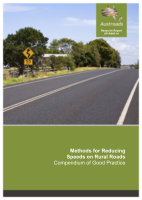Road Safety

- Publication no: AP-R449-14
- ISBN: 978-1-925037-54-8
- Published: 4 March 2014
- PDF (free) Download
This compendium presents information on speed as a contributor to rural road crashes. It provides information on treatments that can be used to address speed, either at key locations (curves, intersections or the approach to towns) or for routes in general. The main focus is on road-engineering-based treatments, but information is also provided on other approaches that may be used (e.g. enforcement and in-vehicle devices).
Detailed information is provided on almost 30 road engineering treatments that may be used to reduce speeds at key locations on rural roads. Information is presented on the speed and crash reduction effectiveness of commonly used treatments. These include advance warning signs, chevron alignment markers, and advisory speed signs at curves; advance warning signs and roundabouts at intersections; and advance warning signs and buffer zones on the approach to towns.
Emerging treatments have been identified, although less reliable information is available on their effectiveness. New and promising treatments include vehicle-activated signs and route-based curve treatments at curves; speed management and vehicle-activated signs at rural intersections; and rural gateway/threshold treatments on the entry to small towns.Other treatments require further investigation, but show some promise. These include in-vehicle speed warning systems for curves (and potentially other locations on rural roads); removing ‘excess’ sight distance at intersections, and methods to highlight the presence of intersections; and road narrowing combined with reduced speed limits.
Limited information is also provided on non-engineering measures (e.g. enforcement).
- 1. Introduction
- 1.1. Background
- 1.2. Intent of the Report
- 1.3. Structure of the Report
- 2. Speed as a Contributor to Rural Crashes
- 2.1. Literature Review
- 2.1.1. Speed within the Safe System Context
- 2.1.2. The Rural Speed Problem
- 2.1.3. How Drivers Select their Speed
- 2.2. Crash Data Analysis
- 2.2.1. Data Analysis Methodology
- 2.2.2. Rural Speed and ‘Not-speed’ Crashes
- 2.2.3. Summary
- 2.3. Surveys of Attitudes to Speeds
- 2.3.1. Australian Attitude Surveys
- 2.3.2. New Zealand Attitude Surveys
- 2.3.3. Summary
- 2.4. Speed Monitoring Data
- 3. Engineering-based Treatments for Reducing Rural Speeds
- 3.1. Rural Curves
- 3.2. Rural Intersections
- 3.3. Railway Level Crossings
- 3.4. Approaching Towns
- 3.5. On Routes
- 3.6. At Work Sites
- 4. Non-engineering Treatments
- 4.1. Enforcement and Penalties
- 4.1.1. Treatment of Rural Speed through Enforcement
- 4.1.2. Speed Enforcement Tolerance
- 4.1.3. Penalties
- 4.2. Education, Training and Publicity
- 4.3. Intelligent Transport Systems
- 4.3.1. In-vehicle Technology
- 4.3.2. Vehicle-to-vehicle Technology
- 4.3.3. Vehicle-to-infrastructure Technology
- 5. Conclusions
- References
- Appendix A Treatments
- A.1 Rural Curves
- A.1.1 Advance Curve Warning Signs – Curves
- A.2 Rural Intersections
- A.3 Level Crossing Treatments
- A.4 Transition Zones
- A.5 Rural Routes and Midblocks
